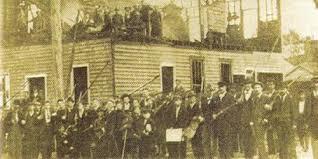
Collier's Weekly Photograph of Mob Outside Wilmington, N.C. Courthouse, Nov. 12, 1898
Toward the conclusion of Charles Chesnutt’s great American novel The Marrow of Tradition (1901), at the culmination of his fictionalized depiction of the 1898 Wilmington (NC) coup and massacre, Chesnutt writes one of the most incisive sentences ever put to paper about the dark realities of American history, community, and identity. A rampaging white mob has burned down the city’s African American hospital, and Chesnutt’s narrator reflects:
The flames soon completed their work, and this handsome structure, the fruit of old Adam Miller’s industry, the monument of his son’s philanthropy, a promise of good things for the future of the city, lay smoldering in ruins, a melancholy witness to the fact that our boasted civilization is but a thin veneer, which cracks and scales off at the first impact of primal passions.
The “primal passions” that have throughout American history revealed the dark realities beneath “our boasted civilization” have taken many forms, but to my mind they have consistently been driven by a particular, discriminatory vision of that civilization itself. That is, it is when definitions of America as a white (or Anglo, or European, or Christian, or English-speaking, or…) nation—what I’m calling in my new book the exclusionary vision of American identity—have been most overtly challenged that the primal passions of white supremacist hate and violence have become most prominent and destructive.
In the last few months I’ve seen such white supremacist primal passions strike at many of the communities I hold most dear. My childhood hometown of Charlottesville, Virginia has of course been the site of some of the most overt displays of white supremacist exclusion, hate, and violence, culminating—if frustratingly not concluding—with August’s rally and the act of domestic terrorism it featured. It’s no coincidence that the Charlottesville rally centered on a statue of Robert E. Lee, as attempts to revise mythologized and false narratives of American history in favor of more inclusive visions represent precisely the kind of challenge to white supremacy that produces exclusionary and violent responses.
This fall, the town of Needham, Massachusetts, where my sons attend school, has featured its own acts of white supremacist hate. In September at my younger son’s elementary school graffiti featuring both expletives and the n-word was written in a boy’s bathroom; a few days ago very similar graffiti was carved into the walls of boys’ bathrooms at Needham High School. As the Boston busing riots reflected with particular (but not at all singular) clarity, attempts to diversify our educational spaces, to have them reflect and highlight an inclusive vision of America, have consistently been met with exclusionary hate and violence, one of many histories that makes clear the truly national scope and scale of these conflicts.
Last week, the walls of Fitchburg State University, where I am in my 13th year as Professor of English Studies and American Studies, featured their own white supremacist expressions. An anonymous community member or members posted signs around campus featuring the white supremacist hashtag “It’s OK to be white” ― the signs were posted directly next to publicity materials for multicultural campus organizations such as the Latin American Student Organization (LASO) and the Black Student Union (BSU). College campuses have of course become a particular space in which white supremacist spokespeople like Richard Spencer and Milo Yiannopoulus seek to advance their exclusionary rhetoric and vision of America, in an attempt to (among other effects) sway young people to these perspectives.
I believe these exclusionary primal passions can also help explain one of the most frustrating current political stories: that the people of Alabama seem quite likely to vote tomorrow for an alleged child molester as their next Senator. In recent days other troubling statements of Moore’s have received media coverage, including his opposition to the 14th Amendment and all the other Constitutional Amendments after the first ten and his belief that America was “great” during the era of slavery. While those statements might seem further disqualifying to those of us who advocate for an inclusive vision of America, they also can help inflame the exclusionary primal passions of those for whom a white supremacist vision rings most true.
What Moore reveals most clearly, that is, is that even the most seemingly basic and shared tenets of “our boasted civilization”—such as protecting young people from predators and threats—can crack and scale off when the primal passions of exclusion and white supremacy are hottest. There is indeed apparently no shared value or ideal that is not expendable in the campaign to produce such an exclusionary and white supremacist community, to “make America great again” in that telling way.
Yet America has never been solely or centrally that white supremacist ideal—instead, that has always represented just one vision, in conflict with alternative, inclusive definitions of our national community and identity. As 2017 comes to a close, it seems clear to me that we are in the midst one of the most heated such conflicts between exclusionary and inclusive visions, and that this battle to define America is one of the most crucial we’ve faced. Whatever happens in Alabama, indeed whatever happens with Trump’s presidency, those of us fighting for an inclusive vision of America will need to keep up our efforts.